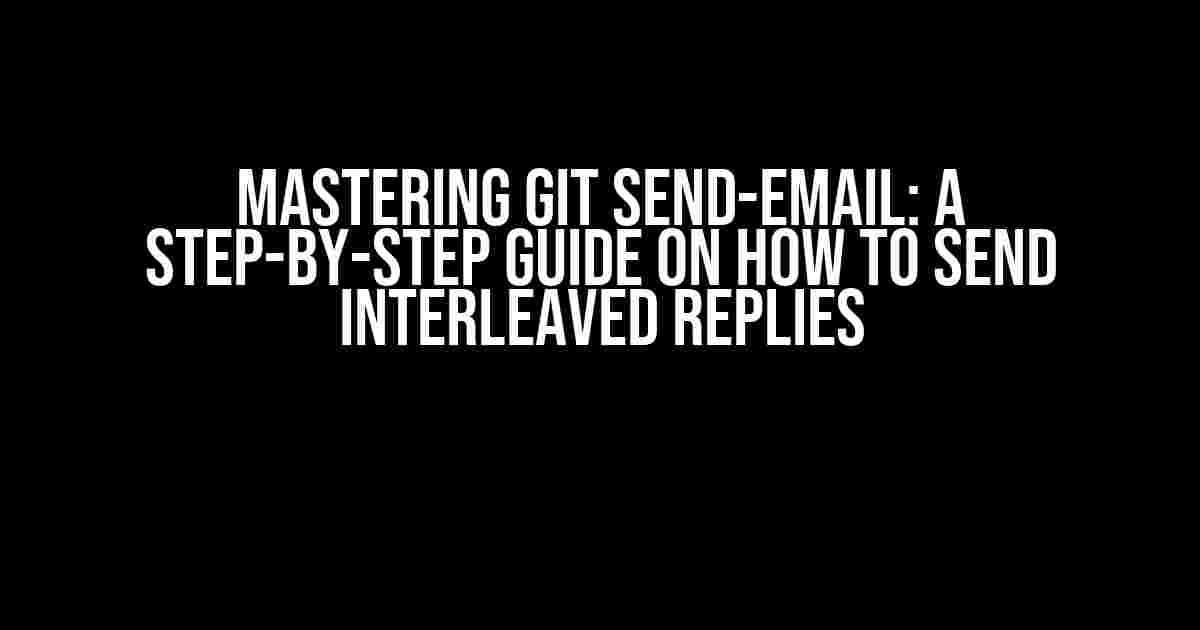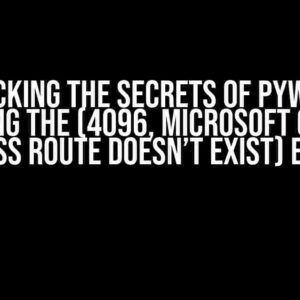Are you tired of sending emails that get lost in the void, only to be responded to weeks later with a cryptic message that leaves you scratching your head? Do you struggle to keep track of conversations that span multiple threads and patches? Look no further! In this article, we’ll dive into the world of Git send-email and show you how to send interleaved replies like a pro.
What are Interleaved Replies?
Before we dive into the nitty-gritty, let’s take a step back and understand what interleaved replies are. In the world of email, an interleaved reply is a response to a specific point or comment in an email thread, rather than a traditional reply to the entire message. This allows for more targeted and organized conversations, making it easier to follow along and respond.
Why Use Git Send-Email?
Git send-email is a powerful tool that allows you to send emails directly from your Git repository. It’s a game-changer for developers, maintainers, and anyone who needs to communicate with others about code changes, patches, or bugs. With Git send-email, you can:
- Send emails with patches or code snippets directly from your Git repository
- Track conversation history and threads with ease
- Use templates to standardize your email formatting
- Automate the email sending process with scripts and hooks
Preparing Your Environment
Before we start, make sure you have the following setup:
# Install Git
sudo apt-get install git
# Install Git send-email
sudo apt-get install git-send-email
# Configure your email client
git config --global sendemail.smtpserver
git config --global sendemail.smtpuser
git config --global sendemail.smtppass Sending Interleaved Replies with Git Send-Email
Now that we have our environment set up, let’s dive into the meat of the article. To send an interleaved reply using Git send-email, follow these steps:
git logto find the commit hash of the message you want to reply to- Create a new email message using
git send-email --compose - In the email body, use the
--in-reply-tooption to specify the commit hash from step 1 - Use the
--threadoption to specify the thread ID of the conversation - Write your reply, making sure to use the
-- interleavedoption to enable interleaved replies - Send the email using
git send-email
# Find the commit hash
git log -1 --format=%H
# Create a new email message
git send-email --compose --in-reply-to --thread --interleaved
# Write your reply
This is my reply to the original message.
# Send the email
git send-email --to= --cc= --subject="Re: Original Message" Understanding the Options
Let’s take a closer look at the options we used in the previous example:
| Option | Description |
|---|---|
--compose |
Creates a new email message |
--in-reply-to |
Specifies the commit hash of the original message |
--thread |
Specifies the thread ID of the conversation |
--interleaved |
Enables interleaved replies |
--to |
Specifies the recipient’s email address |
--cc |
Specifies the CC recipient’s email address |
--subject |
Specifies the subject line of the email |
Tips and Tricks
Here are some additional tips to help you master the art of sending interleaved replies:
- Use
git send-email --annotateto include annotations in your reply - Use
git send-email --no- threadto disable threading - Use
git send-email --identityto specify a custom identity for your email - Use
git send-email --dry-runto test your email before sending
Conclusion
Sending interleaved replies with Git send-email is a powerful way to communicate with others in the world of code. By following the steps outlined in this article, you’ll be well on your way to mastering this essential skill. Remember to experiment with the options and tips provided to take your email game to the next level.
Happy coding, and happy emailing!
Frequently Asked Question
Are you struggling to send interleaved replies using git send-email? Don’t worry, we’ve got you covered! Here are some frequently asked questions to help you navigate this process with ease.
Q1: What is the purpose of sending interleaved replies using git send-email?
Sending interleaved replies using git send-email allows you to send a series of email responses to a single email thread, making it easy to track and reference previous conversations. This feature is especially useful when working on complex projects or collaborating with multiple team members.
Q2: How do I enable interleaved replies when using git send-email?
To enable interleaved replies, use the –interleaved option when running git send-email. For example: `git send-email –interleaved
Q3: Can I customize the subject line when sending interleaved replies using git send-email?
Yes, you can customize the subject line when sending interleaved replies by using the –subject option. For example: `git send-email –interleaved –subject=’Re: Original Subject’
Q4: How do I reference a specific email thread when sending interleaved replies using git send-email?
To reference a specific email thread, use the –in-reply-to option and specify the Message-ID of the original email. For example: `git send-email –interleaved –in-reply-to=’
Q5: Are there any limitations to sending interleaved replies using git send-email?
One limitation to keep in mind is that not all email clients support interleaved replies. Some clients may not display the email thread correctly, or may not allow users to view the entire conversation. Be sure to test your email workflow before sending critical or time-sensitive responses.


